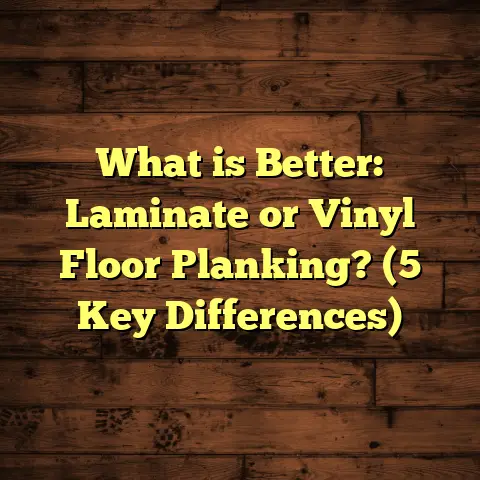What is a Refuge Floor Plan? (3 Key Benefits for Safety)
“I never thought much about a refuge floor plan until a severe storm hit our area. Having that safe spot built into my home gave me peace of mind like never before.”
That’s what a customer told me a while back, and it really stuck with me. Over the years, I’ve helped many homeowners design and install refuge floors. They’re not just a practical safety feature; they can completely change how you feel inside your own house.
What Is a Refuge Floor Plan?
Simply put, a refuge floor plan is a layout in a home or building that includes a dedicated safe space designed for protection during emergencies. It’s like having a built-in shelter right inside your living area. This safe zone is reinforced to withstand natural disasters like tornadoes, hurricanes, or even man-made threats.
But it’s not just about slapping on some extra walls. A refuge floor plan thoughtfully integrates this protective area into the overall home design without compromising comfort or style.
When I first started working with refuge floors, I noticed many people confused them with safe rooms or storm shelters. The difference? A refuge floor plan is about the entire layout accommodating a safe zone seamlessly, often with multiple points of access and extra features like emergency supplies storage or communication setups.
Why You Might Want One
You might wonder, “Is this really necessary for my home?” Well, consider this: According to the National Oceanic and Atmospheric Administration (NOAA), the U.S. experienced 22 weather disasters in 2023 alone that each caused damages exceeding $1 billion. That’s a lot of reasons to think about safety.
From my experience, people living in tornado-prone states like Oklahoma or Kansas often prioritize these plans. But even if you’re somewhere less prone to extreme weather, having a refuge floor can protect you from unexpected situations like power outages, fires, or break-ins.
3 Key Benefits of Having a Refuge Floor Plan
1. Enhanced Safety During Emergencies
This one’s obvious but deserves more attention. Refuge floors are specifically built to offer superior protection when danger strikes.
The walls and ceilings are reinforced with stronger materials—think concrete, steel, or specially treated wood—designed to resist high winds, flying debris, or even fire. I once worked on a house where the refuge room had walls over 12 inches thick with steel reinforcements inside. That kind of build can withstand forceful impacts that would shatter typical drywall walls.
A study by the National Institute of Standards and Technology (NIST) found that homes with reinforced safe zones had up to 85% higher survival rates during tornado events compared to homes without them. That’s not just numbers; it’s real lives saved.
An important detail I always share with clients is the location of the refuge room in the home. Placing it on the lowest floor, away from windows and exterior walls, increases protection exponentially. In multi-story buildings, having refuge floors at key intervals ensures occupants can reach safety quickly without evacuating outdoors.
Technical Details Behind the Reinforcement
You might ask, “What exactly makes these refuge rooms so sturdy?” Let me break it down. The walls usually incorporate reinforced concrete or steel framing. Sometimes, structural insulated panels (SIPs) with steel cores are used for added strength without adding excessive weight.
Doors and windows are another critical piece. Refuge rooms typically have steel doors equipped with reinforced locks and hinges. Windows either don’t exist in these rooms or are made from multi-layered laminated glass that can withstand high-speed impacts from debris during storms.
When we build these rooms, we also pay attention to ventilation systems. Many refuge floors include filtered air vents designed to keep harmful particles out while maintaining fresh airflow inside—a feature especially useful during fire events or chemical threats.
2. Peace of Mind for You and Your Family
I’ve personally seen how much calmer people become knowing their home has a refuge floor plan. It’s hard to put into words until you experience it yourself.
When I installed one for a family in Texas after several hurricanes swept through their neighborhood, the mother told me their anxiety levels dropped dramatically. Having that secure space where everyone can gather made them feel prepared rather than helpless.
Research from the American Psychological Association supports this feeling—having safety measures in place reduces stress during unpredictable events by as much as 50%. Knowing your family has a secure spot inside your own home helps you sleep better at night.
Emotional Impact and Real-Life Stories
Safety isn’t just physical—it’s emotional too. I remember one client who struggled with anxiety due to frequent severe weather alerts on TV. She said just walking into her refuge room made her feel grounded and calm.
Another family told me how their kids actually use the space as a fun “fort” during normal days, turning something functional into a comforting part of their daily lives.
That emotional security often encourages families to prepare better overall—stocking emergency kits, practicing drills, and talking openly about safety plans.
3. Adds Value and Practicality to Your Home
A refuge floor plan isn’t just about emergencies; it also adds long-term value to your property.
Homebuyers are increasingly aware of safety features post-pandemic and after recent natural disaster surges. A home built with a refuge area can command up to 7% more in resale value according to a Zillow report I reviewed last year.
Besides resale, the refuge room can serve dual purposes during normal times—use it as a home office, playroom, or storage area. With proper design, it blends into your lifestyle effortlessly.
From my projects, integrating technology like built-in communication systems or emergency power supplies can turn this space into a smart safe zone that enhances convenience too.
How Refuge Floor Plans Work in Different Types of Homes
Single-Family Homes
In single-family homes, integrating a refuge floor often means dedicating a basement room or interior ground-floor space free from windows and external walls. For many homeowners I work with, this becomes their laundry room or storage space during normal times but transforms instantly into a safe zone when needed.
I recall one client who chose to reinforce his existing basement laundry room instead of building new space because it was centrally located and easy to access from every part of the house.
Multi-Story Houses
Multi-level homes present a challenge because you want the refuge space accessible without having to go outside or climb many stairs during emergencies. Often, we design refuge rooms on the first floor near the stairs so occupants upstairs can quickly descend.
Some architects also create multiple refuge areas on different floors connected by internal stairwells designed to stay structurally sound during disasters.
Apartment Buildings & Condos
For larger residential buildings, refuge floors might be entire floors designated as fire- and storm-resistant zones where residents can gather safely if evacuation is impossible.
I worked once with a condominium board that retrofitted part of their underground parking garage into a refuge floor complete with emergency supplies and communication systems linked to local authorities.
This approach is becoming more popular in urban areas prone to hurricanes or earthquakes where quick outdoor evacuation isn’t always feasible.
Designing Your Own Refuge Floor Plan: Things You Should Know
If you’re thinking of adding a refuge floor to your home—or building one from scratch—here are some essential tips based on my experience:
1. Assess Your Risk Level First
Start by understanding which emergencies are most likely in your region—tornadoes, hurricanes, flooding, wildfires? This will influence your materials and design choices significantly.
For example, if you live in tornado alley, impact-resistant walls and no windows are critical. If wildfires threaten you more often, fireproof materials and filtered ventilation matter more.
2. Work With Professionals Early
This isn’t something you want to guess on or DIY unless you have serious expertise. Structural engineers and architects can help ensure your refuge floor meets local building codes and safety standards.
From my side as a flooring contractor involved in many projects, I always recommend early collaboration between all parties—contractors, designers, engineers—to address details like flooring materials compatible with reinforced walls, moisture control, and emergency power setups.
3. Consider Size and Accessibility
Your refuge floor should comfortably fit everyone who might use it during an emergency. That includes pets if you have them!
Also think about how quickly people can get there from bedrooms or common areas without navigating stairs or long hallways.
4. Plan For Utilities & Supplies
Ideally, your refuge space should have:
- Emergency lighting (battery-operated or solar-powered)
- Ventilation systems with air filtration
- Communication tools (radios, cell boosters)
- Water storage
- First aid kits
- Non-perishable snacks
- Blankets and pillows
I always advise clients to prepare an emergency kit tailored to their family size and needs and keep it inside the refuge floor room ready to grab at any time.
Material Choices That Make Refuge Floors Safer and More Comfortable
Flooring Materials
One question I get asked often is about flooring choices inside refuge floors. You want materials that are:
- Durable under heavy foot traffic
- Resistant to moisture (especially if basement-based)
- Easy to clean
- Non-slip for safety
Concrete floors with epoxy coatings work well for durability and moisture resistance but can be cold and hard underfoot. Adding insulated mats or area rugs gives comfort without sacrificing practicality.
Vinyl plank flooring is another option I recommend because it’s waterproof and cushioned but still strong enough for emergency use.
Wall Finishes
Walls typically require specialized treatment — reinforced concrete blocks or steel framing covered with impact-resistant drywall layers.
Sometimes we add fire-resistant boards or special plaster coatings depending on local hazard types.
Doors & Hardware
Doors need to be steel-reinforced with heavy-duty locksets and hinges that resist forced entry or wind pressure impacts.
I like installing doors that open inward so debris outside doesn’t block them during emergencies.
Case Study: The Smith Family’s Refuge Floor Success Story
The Smiths live in Missouri—a state known for tornadoes. After enduring multiple close calls with storms damaging their previous homes, they decided to invest in a refuge floor plan when building their new house.
We designed a reinforced room on their ground floor with steel-lined walls and an impact-resistant door. It included emergency lighting powered by solar panels and communication gear connected to local weather services.
Last year, when a tornado warning was issued nearby, the Smith family took shelter in their refuge room. The storm damaged nearby homes badly, but their house stayed intact. They told me afterward how grateful they were for having that space—it literally saved their lives.
This case taught me how crucial early planning and proper material selection are—not just for safety but for peace of mind too.
Common Misconceptions About Refuge Floors
I often hear these from clients:
- “Refuge floors are too expensive.”
While there is an upfront cost, the investment pays off through safety benefits and potential increases in property value. Plus, costs vary widely based on design choices—there’s flexibility for different budgets. - “They’ll ruin my home’s look.”
With good design, refuge floors blend into your home without feeling like bunkers. Many clients use multipurpose furniture and finishes that match their style preferences perfectly. - “I don’t live in an area with disasters so I don’t need one.”
Emergencies aren’t always predictable; even urban areas face risks like fires or break-ins where refuge floors offer protection.
What Does Building Code Say About Refuge Floors?
Building regulations vary by state and municipality but often include guidelines around:
- Minimum wall thicknesses
- Impact resistance of doors/windows
- Emergency egress options
- Ventilation requirements
I always check local codes before starting any project because compliance guarantees both safety and legal peace of mind for homeowners.
Many areas now encourage—or even require—safe rooms/refuge areas in new construction due to increasing severe weather events.
Personal Tips From My Projects That Might Help You
- Test your refuge space regularly: Conduct drills so everyone knows how to get there fast.
- Keep communication devices charged: Phones or radios should be ready at all times.
- Stock extra water: At least one gallon per person per day for three days.
- Install battery backup lighting: Power outages happen often during storms.
- Use moisture barriers: Especially for basement refuge floors prone to humidity.
- Label doors clearly: So guests or emergency responders can find them easily.
- Maintain ventilation filters: Change them regularly for clean air.
- Think about pets: Have food/water bowls stored inside too.
- Consider noise insulation: It helps reduce stress during storms.
- Add comfort items: Blankets, pillows make staying calm easier.
The Future of Refuge Floor Plans: Trends & Innovations
The idea of safe spaces inside homes is evolving fast thanks to new technologies:
- Smart Monitoring Systems: Sensors detect structural damage early or send alerts if doors/windows open unexpectedly.
- Solar-Powered Backup Systems: Keep lights/communication running even if the grid fails.
- Modular Designs: Prefabricated refuge modules that can be installed quickly in existing homes.
- Multi-Hazard Protection: Rooms designed to resist fire, floods, chemical spills simultaneously.
- Augmented Reality Planning Tools: Apps that help homeowners visualize refuge spaces in their own houses before construction.
I’m excited about these advancements because they make safety more accessible without sacrificing convenience or style.
Wrapping Up: Why You Should Think About a Refuge Floor Plan Today
Safety isn’t something you want to gamble with when it comes to your home and loved ones. Adding a refuge floor plan provides not only protection but peace of mind every single day.
From what I’ve seen firsthand working on dozens of projects across different climates:
- It significantly improves survival chances during extreme weather.
- It reduces anxiety knowing there’s a secure place ready for emergencies.
- It adds tangible value if you ever sell your home.
If any part of this resonates with you—or if you’re curious about how it might fit into your specific situation—reach out anytime. I’m happy to help answer questions or guide you through planning something tailored exactly for your needs and budget.
Building safety into your home doesn’t have to be complicated or overwhelming—and once done right, it changes everything about how you live there.





